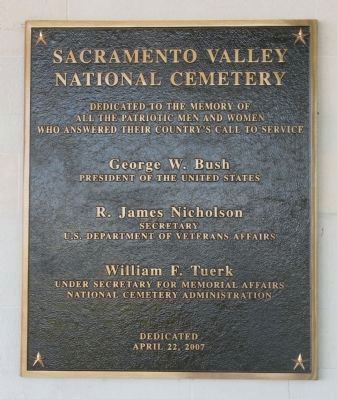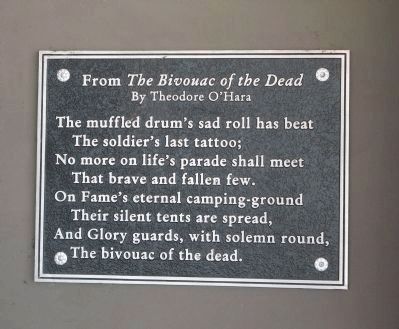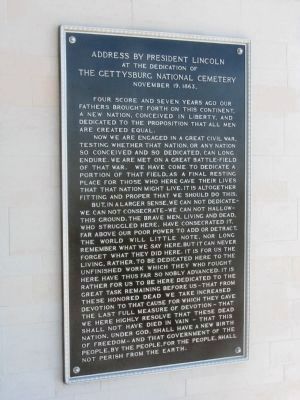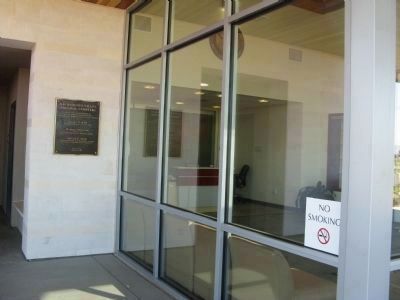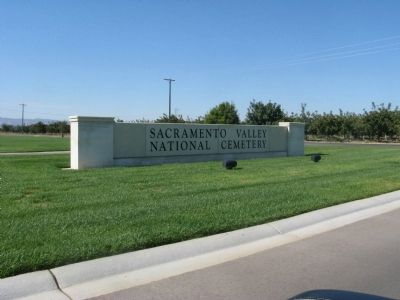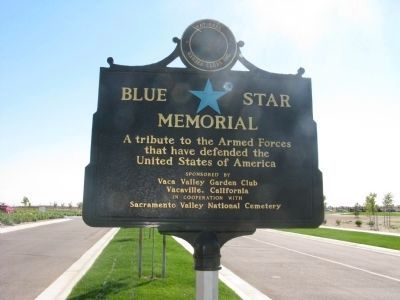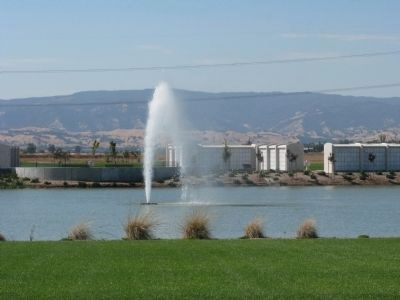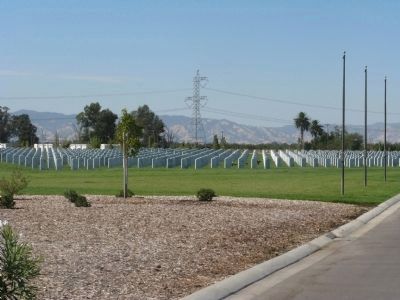Dixon in Solano County, California — The American West (Pacific Coastal)
Sacramento Valley National Cemetery
all the patriotic men and women
who answered their country’s call to service.
George W. Bush
President of the United States
R. James Nicholson
Secretary
U.S. Department of Veterans Affairs
William F. Tuerk
Under Secretary for Memorial Affairs
National Cemetery Administration
by Theodore O’Hara
The soldier’s last tattoo;
No more on life’s parade shall meet
That brave and fallen few.
On Fame’s eternal camping-ground
Their silent tears are spread,
And Glory guards, with solemn round,
The bivouac of the dead.
Erected 2007 by Bureau of Veterans Affairs.
Topics and series. This historical marker is listed in these topic lists: Cemeteries & Burial Sites • Military. In addition, it is included in the National Cemeteries, and the Southern Pacific Railroad series lists.
Location. 38° 24.833′ N, 121° 52.437′ W. Marker is in Dixon, California, in Solano County. Marker is on Midway Road south of Interstate 80. All three plaques are mounted on the front of the Sacramento Valley National Cemetery Administration Building. Touch for map. Marker is at or near this postal address: 5810 Midway Road, Dixon CA 95620, United States of America. Touch for directions.
Other nearby markers. At least 8 other markers are within 8 miles of this marker, measured as the crow flies. Village of Silveyville (approx. 3.4 miles away); Halfway House (approx. 3.4 miles away); The Methodist Church of Dixon (approx. 3½ miles away); Nut Tree (approx. 5.6 miles away); Old Town Hall (approx. 7.3 miles away); Walker Opera House (approx. 7.3 miles away); The Odd Fellows Hall (approx. 7.3 miles away); Built 1864 (approx. 7.3 miles away). Touch for a list and map of all markers in Dixon.
Regarding Sacramento Valley National Cemetery. Sacramento Valley National Cemetery is the seventh national cemetery built in California and the 124th in the national cemetery system.
Like many lands in the western United States, the Homestead Act of 1862 facilitated the settlement of the site of what is now the Sacramento Valley National Cemetery. In the late 1860's, the site consisted of nine separate parcels, which were subsequently acquired by private citizens through preemption (an individual's right to settle land first and pay for it later) and homestead claims. During the 20th century, these separate parcels were gradually consolidated under one owner. The site was continuously used as farmland from the 1860's until it was purchased by the National Cemetery Administration in 2004. Crops raised on the property at the time of NCA's purchase included corn, alfalfa, beans, squash, and peppers.
The Union Pacific Railroad, formerly the Southern Pacific Railroad, and prior to that the Central Pacific Railroad, intersects the southeastern corner of the property. In May 1869, the famous golden spike was driven in Promontory Summit, Utah, to symbolically mark the completion of the “First Trans-Continental Railroad,” connecting Omaha, Nebraska, to Sacramento. However, the rail network did not actually reach the Pacific Ocean until the completion of the Central Pacific Railroad, connecting San Francisco and Sacramento in November of that year.
The First Trans-Continental Railroad linked the West Coast with the existing railroad network in the eastern United States, and contributed dramatically to the economic development and population growth of California. The Southern Pacific Railroad leased the Central Pacific railroad in 1885; over time, the Southern Pacific Railroad grew into a massive railway network throughout the Western and Southwestern United States, stretching down from Portland, Oregon to New Orleans. The Southern Pacific Railroad was acquired by the Union Pacific Railroad in 1996.
Sacramento Valley
National Cemetery opened for burials in 2006, and was formally dedicated on April 22, 2007.
(Source: Sacramento Valley National Cemetery web-site
http://www.cem.va.gov/cems/nchp/sacramento.asp)
Additional keywords. Veterans Memorials
Credits. This page was last revised on February 1, 2021. It was originally submitted on October 10, 2010, by Syd Whittle of Mesa, Arizona. This page has been viewed 1,996 times since then and 34 times this year. Photos: 1, 2. submitted on October 10, 2010, by Syd Whittle of Mesa, Arizona. 3, 4, 5, 6, 7, 8, 9, 10. submitted on October 11, 2010, by Syd Whittle of Mesa, Arizona.
